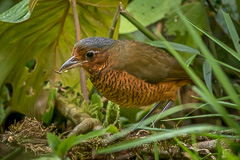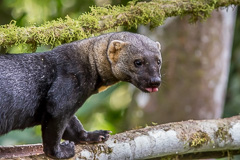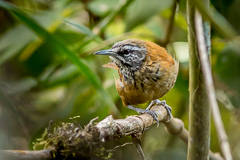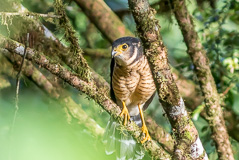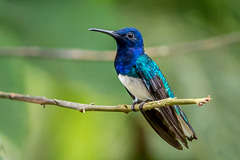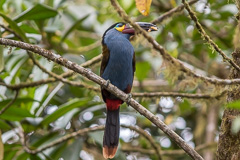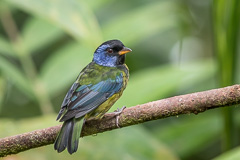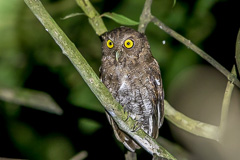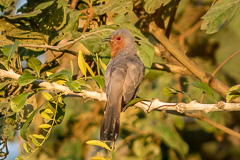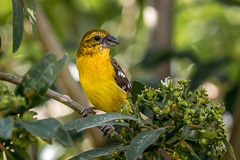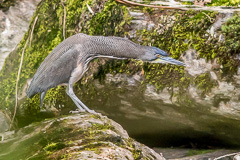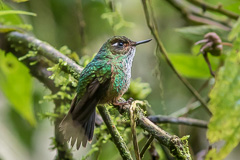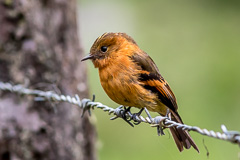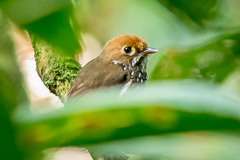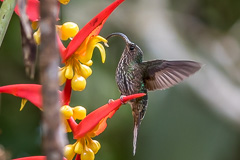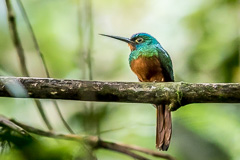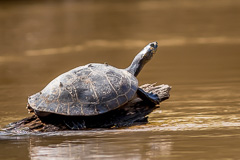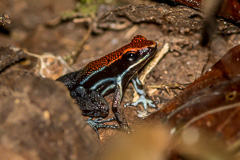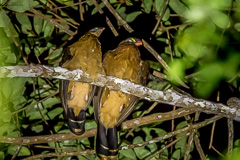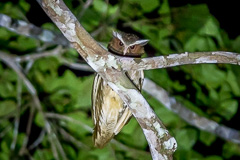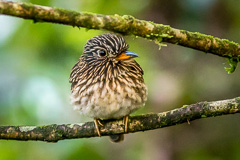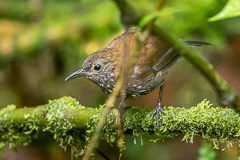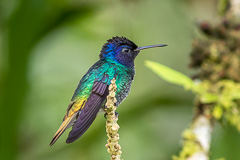Overview
Dates: |
16 Aug - 14 Sep 2019. |
With Richard Carden. This northern Ecuador trip was tacked on to a long-planned Galápagos trip. As we'd both birded Ecuador previously, this was primarily deemed a clean-up, targeting some difficult and desirable species. All in all a great trip, with some spectacularly rare, or personally much sought after, species found - Nocturnal Curassow, Peruvian Antpitta, Mountain Avocetbill and Giant Antpitta to name a few. However, for some unfathomable reason we failed to find a fair number of commoner species we'd expected. We arranged logistics and guiding with Mindo guide Alex Luna, who was both excellent in the field and great to travel with. We thoroughly enjoyed the trip, and in common with most trips in South America, longer stays at all localities would have been desirable.
Itinerary
14 - 16 Aug. A lengthy journey on Bangkok Airways and KLM with routing Chiang Mai - Bangkok - Amsterdam - Quito. However, this two day journey turned into a three day epic due to a bird strike disabling a plane, resulting in a missed connection to Quito and a 24 hour delay in Amsterdam. Eventually arrived 14:40 in Quito, having passed immigration and customs formalities without issues, then collected by pre-arranged taxi for the two hour drive to Tandayapa Bird Lodge. Here, met up with Richard in the late afternoon. As on arrival at Tandayapa only an hour of light remained, and conditions were overcast with drizzle, only a few hummingbirds were found around the lodge, including Purple-bibbed Whitetip, White-booted Racket-tail, Rufous-tailed Hummingbird, Lesser Violetear, Fawn-breasted Brilliant and Violet-tailed Sylph.
17 Aug. Having arrived a day later than planned, only a single night was possible at Tandayapa. We started with an early morning drive to Refugio Paz de las Aves, about 40 minutes away. Although the turn off from the highway is signed, the actual meeting point is not, so if visiting make sure you have a GPS reference. As we'd arranged this on the fly, when we actually met up as arranged at 06:00, we found we were joining several other groups resulting in a party of 16 people. Not ideal, and why do so many would-be birders like to natter so much in the field? We started with an hour at the Andean Cock-of the-Rock lek, where good numbers were active, plus a single Brown Inca and a distant Golden-headed Quetzal. Handily, we were then shown a Lyre-tailed Nightjar on its nest; only for the silence to be broken by our vehicle alarm. Ecuadorians are paranoid their vehicles are going to be stolen and most are fitted with incredibly complicated alarm systems. The systems beep loudly when the vehicle is locked, unlocked, doors left open, the wrong door opened first, wrong start code entered into the ignition or a whole host of other programmed items. When renting, try if possible to find a vehicle without an alarm!
Next up, we were taken to the spot where, the now famous, Maria the Giant Antpitta is fed daily. An impressive beast to say the least, after which headed toward some feeders, finding Orange-breasted Fruiteater along the way. At the feeders were Toucan Barbet, Golden-naped Tanager and Blue-winged Mountain Tanager, though we didn't stay long to admire them before heading down a short trail to where Ochre-breasted Antpitta was successful found, but Moustached Antpitta heard only. Finally, a short drive to the Yellow-breasted Antpitta spot where a combination of time of day, too many people and the car alarm again ensured the bird was uncooperative, even though calling close by. In the heat of the late morning, a notable number of butterflies were active, plus our final bird of the morning, a Rufous-breasted Antthrush. Drove back to Tandayapa for lunch, during which a Tayra and Crimson-rumped Toucanet visited the bird table. Checked out and returned to Quito airport, with an overnight at the adjacent Wyndham Hotel, where we met with the other 13 people scheduled for our Galápagos trip tomorrow. 18 - 26 Aug. An eight day birding cruise around the Galápagos Islands. Trip report here. |
26 Aug. Our Avianca flight from Baltra arrived pretty much on time, although the ensuing wait for baggage meant it was noon before we left the terminal to meet our pre-arranged taxi. Before departing the airport we visited the Customer Service Centre of Claro, the country's largest mobile provider, to purchase a local SIM/Internet card. Ecuador simply does not make SIM cards easy to obtain. The first issue is finding a shop open. Even at the International Airport the Claro centre is only open during usual office hours, and closed on both Saturday afternoons and Sundays. By law only Ecuadorian citizens are permitted to own a SIM card, so operators work around this by registering the card to themselves, then ensuring they copy your passport. It took more than 30 minutes to set up our SIM cards, even with the staff doing it! From the airport we headed 20 minutes to Zaysant Eco-Lodge on the edge of the city. We found this an excellent choice of location for an overnight stay; reasonably close to the airport, not expensive, quiet and comfortable with a few birds in the large garden. The accommodating staff also make us breakfast at 04:45. As bonus this night, we were also the only guests. We met up with Alex, returning from a previous trip, later that evening.
27 Aug. We left just after 05:00 to drive the 90 minutes to Reserva Yanacocha. Bright and, at 3,500 metres, not as cold as expected, but very windy. All morning we birded along the main trail which, as mostly in the shade, proved rather quiet.
When the sun finally did decide to come out, the weather appeared to then become too warm and sunny. So some tough birding with only a single small feeding flock recorded all morning. However, later in the morning we lucked on to Ocellated Tapaculo and Equatorial Antpitta, though we somehow managed to miss all four of our target species. Lunch at the visitor centre with Shining Sunbeam at the feeders, then a slow drive down the hill in the direction of Tandayapa. Similarly frustrating birding and only in the late afternoon, way downhill, did we finally catch up with one of our targets - Western Hemispingus. Continued to Mindo, arriving 18:20, where we checked into one of the many accommodations near the river. 28 Aug. An early 05:00 start to Recinto 23 de Junio. This private farmland with adjacent forest is one of the best places to observe the aptly-named Long-wattled Umbrellabird. Our morning walk produced several umbrellabirds plus a long list of other goodies including Sickle-winged Guan, Barred Forest Falcon, Velvet-purple Coronet, Choco Tyrannulet, Guayaquil Woodpecker, Golden-winged Manakin, Yellow-collared Chlorophonia, Choco Brushfinch and Black-chinned Mountain Tanager. About 9:30 we met the owner for coffee and empanadas, plus finding another Choco Tyrannulet in the garden, plus the only Scrub Blackbird of the trip. |
Next up, we drove 45 minutes to Milpe Bird Sanctuary where we walked several trails around the visitor centre. Good forest together with a well-maintained set of trails. On our walk we encountered one mega mixed feeding-flock containing at least 20 species, though of course struggled to appreciate them all properly as they whizzed through the canopy.
Lunch in the nearby town at a small restaurant with great valley views, good food and bird feeders; the latter having Black-cheeked Woodpecker on bananas plus a bush full of oblivious Green Thorntail. Returned to Milpe for the remainder of the day. Our hours here gave us, White-whiskered Hermit, White-necked Jacobin, Andean Emerald, Green-crowned Brilliant, Crimson-rumped Toucanet, Scaly-throated Foliage-gleaner, Lineated Foliage-gleaner, Spotted Barbtail, Rufous-rumped Antwren, Russet Antshrike, Esmeraldas Antbird, Zeledon's Antbird, Pale-vented Thrush and White-winged Tanager. Overnight at Mindo. |
29 Aug. A 40 minute drive to Santa Rosa Bird Lodge, a private lodge, well set up, with feeders and hides. Our main targets here were Yellow-breasted Antpitta and Hoary Puffleg, both of which were allegedly visiting daily. On arrival at 06:00 we headed straight to the hide, where a good selection of species were found active very early in the half light, including Spillman's Tapaculo, Golden-bellied Flycatcher, Choco Brushfinch, a single Yellow-breasted Antpitta, Pearled Treerunner and Montane Woodcreeper.
After an hour here we restationed ourselves at the hummingbird feeders. Unfortunately the day turned into a nine hour marathon of waiting in vain for the supposed Hoary Puffleg. Most disappointing to say the least. Some rain late afternoon, otherwise cool and dry with scattered cloud. During the day, the hummingbirds attending the feeders included Vevlet-purple Coronet, Empress Brilliant, Fawn-breasted Brilliant, Collared Inca, Brown Inca, Gorgeted Sunangel and Violet-tailed Sylph, plus Plate-billed Mountain Toucan nearby. At 16:15 we gave up on the puffleg and headed back to Mindo to check out a nearby site where Blue Seedeater was apparently breeding. Unfortunately we failed to find this either. 30 Aug. The whole day spent birding/driving a long loop through Milpe Conservation area with a visit to the feeders at the Mashpi - Amagusa Reserve, where Moss-backed Tanager seen well. Our long day in the field ended with an impressive list, including Dusky Pigeon, White-throated Quail-Dove, Green-fronted Lancebill, Barred Puffbird, Smoky-brown Woodpecker, Pacific Tuftedcheek, Uniform Treehunter, Bronze-olive Pygmy Tyrant, Orange-breasted Fruiteater, Scaled Fruiteater, Purple-throated Fruitcrow, Black Solitaire, White-thighed Swallow and Choco Vireo. Our last night in Mindo. |
31 Aug. Another 05:00 start with a drive to the Mashpi Shungito Reserve, where we met with owner Alexandro. Naturally, our target here was the Rufous-crowned Antpitta - basically the only reliable site in the world for this highly elusive species. This bird had been reliable here for many years. However, it was ominous that Alexandro mentioned the bird had not been seen in more than a week. And indeed it proved still to be missing as we scoured the area all morning, eventually leaving later than planned to drive to Canandé. Some species we did find while hunting the antpitta were Spot-crowned Antvireo, Pacific Antwren, Broad-billed Motmot, Northern Schiffornis, Dot-winged Antwren, Rufous-tailed Jacamar and Northern Plain Xenops. Missing this antpitta has to be considered the worst dip of the trip. It took almost six hours, much on rough, dusty roads, before reaching Canandé Reserve where we checked in to its small lodge run by the Jocotoco Foundation. In the immediate vicinity were Purple-breasted Hummingbird, Rufous-tailed Hummingbird and Long-tailed Tyrant.
Rain, starting at dusk, continued till 20:30, after which a short walk produced not a single night bird. However, we were hauled out of bed at 23:00 for fantastic views of Choco Screech Owl by the lodge, expertly picked out by Alex. 1 Sep. We started at first light, at 06:10, birding the three kilometre trail to the viewpoint. Damp, overcast and foggy all morning, which kept bird activity low. During lunch at the viewpoint a Choco Trogon was nearby, plus Black-tipped Cotinga and King Vulture in the valley below. |
With improving weather, the afternoon was spent on the reverse walk, back to the lodge. Of course we half hoped, half fantasised, for Banded Ground Cuckoo on these trails, but of course no luck with this near mythical bird. A great haul of species throughout the day included Plumbeous Forest Falcon, Lita Woodpecker, Tawny-faced Quail, White-whiskered Puffbird, Red-rumped Woodpecker, Cinnamon Woodpecker, Moustached Antwren, Ocellated Antbird, Northern Barred Woodcreeper, Ochre-bellied Flycatcher, Rufous Mourner and Red-capped Manakin.
2 Sep. Light rain all night continuing into the morning. An 06:00 start on a different trail. Rain and overcast for the first couple of hours. A small ant swarm was found which had Bicoloured Antbird, Ocellated Antbird and a single Sapayoa in attendance. We also finally caught up with Blue-whiskered Tanager. Reluctantly, we had to leave by 11:00 for long drive north to Las Peñas. En route we stopped again, as we'd done in the drive in, to look for Large-billed Seedeater - this time very successfully, although views were brief. When we hit the Pacific coast we started to pick up hundreds of Magnificent Frigatebird and Brown Pelican.
Having arrived at Las Peñas before dusk we just had time to look for Dwarf Cuckoo. This bird is so rare in Ecuador that it was even a lifer for Alex! For our overnight we randomly picked one of the cheaper beach hotels in town, which was OK but had nothing to recommend it. Conversely, dinner along the beach front, at a small family run restaurant, produced some of the best seafood ever. 3 Sep. We left at 05:00 start to drive the two hours to the Awa Road. Low thick cloud, so another slow start to the day. However, it became blazingly hot by 09:15, so birding had to be packed in to a couple of hours. During our two hour hunt for the target Choco Tapaculo we picked up Stub-tailed Antbird, Rufous Mourner and Black-striped Sparrow. By the time we left at 10:30 we'd also picked up White-ringed Flycatcher. Next, we drove to Lita to look for Ruddy-breasted Seed Finch but in the heat of day this was, hardly surprisingly, unsuccessful. Our next stop, in the dry inter-Andean valleys around Mira, to scan for White-tipped Swift, produced one small flock. Then another hour to Laguna de San Pablo just outside Ibarra, for an Ecuadorian Rail hunt. A number of other species in the vicinity were new for the trip list, including Yellow-billed Pintail, Pied-billed Grebe, Harris's Hawk, Tufted Tit-Tyrant, Hooded Siskin and Blue-and-yellow Tanager. We left the area at 16:30 to drive to Quito where we again stayed at Zaysant Lodge. A busy day. |
4 Sep. This point in the trip marked the end of the western Andes, with us now embarking on the eastern slope and Amazonia, during which we were expecting wet weather. Left Quito at 05:15 to drive over the pass at Papallacta and down to Guango. Due to the miserable weather at the 4,500 metre pass we didn't stop for birding. By the time we arrived at Guango Lodge, at 2,500 metres, we were just about below the cloud level, though rain was still falling. We spent a wet morning walking one of the trails uphill from the lodge. With the weather drying and clouds lifting by 10:00 we had an excellent morning's birding with Andean Potoo, Mountain Avocetbill, Tawny-breasted Tinamou, Pale-footed Swallow and many others. Immediately following lunch, some birding and photography of hummingbirds around the lodge, then out again at 14:00 walking the trail adjacent to the river, but almost nothing found, due heavy rain from 15:00 which continued on/off till late. A brief walk at 16:30, between showers, had one good flock with Black-eared Hemispingus, Hooded Bush Tanager, Blue-and-black Tanager, Black-capped Hemispingus and Montane Woodcreeper. As our target list here was quite small we stayed only a single night. The food was excellent - probably the best of the trip - but note that the rooms are incredibly small, with our twin room having insufficient floor space to even open a suitcase. |
5 Sep. Cool and overcast all day, so pretty good birding weather we thought, However, the species found were not as impressive as during yesterday's rain. We started with a repeat walk along the river, with a couple of good flocks adding Rufous-breasted Flycatcher and Hooded Mountain Tanager to the trip list. We then walked the same loop as yesterday, again finding Mountain Avocetbill, plus Grey-browed Brushfinch and Slaty-backed Chat-Tyrant.
Lunch at the lodge, followed by a drive to the San Bermejo Road, situated on the eastern flank of the Reserva Ecologica Antisana. The habitat now consists of extremely hacked-over forest and farmland, but in three hours we managed Rufous-crowned Tody-Flycatcher, Streak-headed Antbird, Andean Motmot and Torrent Tyrannulet. Late afternoon we headed to Cabañas San Isidro. Unfortunately rain started at dusk resulting in a fair wait for the resident San Isidro Owl that put in a brief appearance at 21:15. The taxonomy of this bird is currently unresolved, and thought to be either a race Black-banded Owl or an undescribed species. |
6 Sep. Rain most of the night continued into the morning. A relative lie-in, with breakfast at 06:00, after which we investigated the local hide, which held Oleaginous Hemispingus, Grey-breasted Wood Wren and Flavescent Flycatcher. At 07:30 we joined the daily feeding of White-bellied Antpitta, which didn't disappoint, then headed off, to walk the Guacamayos Ridge. As the weather was still wet, birding was poor till after 10:00 when the cloud lifted a little. With improving weather we, somewhat surprisingly, found Barred Antthrush, but not the hoped-for Greater Scythebill or Peruvian Antpitta. Back to San Isidro for a late lunch, after which, on a whim, we decided to take a look at one of the trails around the lodge.
Although Peruvian Antpitta is know from the lodge, and several years ago had been actively fed, no recent sightings were known. However, not to be deterred, we decided to venture farther from the lodge, and were amazed when we heard a bird at reasonable range. Even more amazingly we simply walked into the forest and saw it. How much luck can one have in a day? We also found Black-chested Fruiteater in the vicinity. Mid afternoon we drove to Wild Sumaco Wildlife Sanctuary for a two night stay - a welcoming, comfortable lodge, with great birds and trails, though be warned, having laundry done here is crazily expensive. |
7 Sep. We started on Coopman's Trail, with several feeding flocks, containing Orange-eared Tanager, Spotted Tanager, Ashy-headed Chlorospingus, Ecuadorian Tyrannulet, Black-faced Dacnis and Yellow-eyed Dacnis to name but a few.
Later, we walked the Lodge Trail with Marble-faced Bristle Tyrant and Blue-rumped Manakin and, just prior to lunch, we staked out the hummingbird feeders, which had at least a dozen species including Napo Sabrewing, Black-throated Mango and Gould's Jewelfront, plus a White-tipped Sicklebill on Heliconia at the restaurant door. In the afternoon we walked the FACE Trail, eventually finding the neck-breaking Buff-throated Pygmy Tyrant and Short-tailed Antthrush. Below the Laniisoma Trail we recorded our only Coppery-chested Jacamar of the trip. Rain stopped play at 17:30, when we became caught out in a downpour, which eventually petered out, though too late for any night birding. Band-bellied Owl called twice, above the accommodation at 02:00. 8 Sep. Beautiful weather all day. No sooner had we stepped out of the door at dawn, than several Military Macaw passed over. We then took a short drive downhill to the Piha Trail, where along the roadside we had Black-and-white Tody-Flycatcher, Yellow-bellied Tanager and Foothill Elaenia. A nice start to the day. All morning we walked the Piha Trail, finishing with the, very steep, Waterfall Trail on the return. No luck at all with Wing-banded Wren, but the walk produced a couple of flocks with Ruddy-tailed Foliage-gleaner, Fulvous Shrike-Tanager, Collared Trogon, Ecuadorian Piedtail, Wire-crested Thornbill, Peruvian Racket-tail, Ornate Stipplethroat, Yellow-breasted Antwren, Olivaceous Woodcreeper and Large-headed Flatbill. |
The afternoon was spent mainly searching open areas along the road to the highway, with three species giving us an enormous runaround - Blackish Rail, Grey-chinned Hermit and Olive-chested Flycatcher. Late afternoon another, failed, attempt for Wing-banded Wren, though we lucked into White-throated Quail-Dove.
9 Sep. Dry all night, but heavy rain, which started at 05:00, effectively knocked out early birding. Amazingly, just as we left at 07:15, the rain ceased, though as we had a long drive ahead of us we could only make one short stop for Large-headed Flatbill. Two hours later we arrived in the hot lowlands at Coca, where we met up with Jarol Fernando Vaca the manager of Shiripuno Amazon Lodge. From Coca we had a 90 minute taxi journey to the pier in Shiripuno town, where we spent a couple of hours loading the boat with all the provisions plus staff we would need for our time up-river. Around the dock were White-banded Swallow, Short-tailed Swift and Grey-breasted Martin.
We finally got underway at 13:15, but due to the low water levels it took almost five hours before we completed the 60 kilometres to the lodge. This was a rather tough journey, in an open boat with the sun beating down fiercely. And to top it all, in many places it was necessary to take fast runs at submerged trees and literally power the metal boat over them. Some skilful boatmen here! Due to this being low season, the lodge was unoccupied, so it was necessary to make it operational, which took a couple of hours. We were fortunate as well to be able to have Jarol as our local guide at Shiripuno, as his experience and skill in the field were exceptional. |
It should be noted that Shiripuno Lodge is distinctly basic. Those expecting gin and tonics on the veranda at sunset will be sorely disappointed. This is a place for hard-core naturalists wanting to experience remote forest and some very sought after birds. Limited power, for lighting and charging, was available a couple of hours in the evening only. Night birds even kept us awake - especially the annoying Common Pauraque that sat just outside the rooms. Late evening the booms of Nocturnal Curassow could be heard. Wonderful.
10 Sep. We left the lodge at day break, spending the morning on a five kilometre loop, first along the river, then heading back inland. Already hot by 10:30, so birding slow after that. Highlights of the morning were probably a pair of Salvin's Curassow and Ruddy-tailed Flatbill. Most frustrating was Dugand's Antwren which was never seen well. Immediately after lunch, during the heat of the afternoon, we took a short walk immediately behind the lodge. This proved amazingly productive with Grey-winged Trumpeter, Variable Woodpecker, Green Manakin and Yellow-billed Jacamar.
At 16:00 we took a boat down river, in order to walk the return to the lodge after dark, for nightbirds. Great Jacamar found, and after dark we heard Common Potoo and Long-tailed Potoo. Unfortunately just as we heard the Long-tailed Potoo, a big target, Nocturnal Curassow started calling - an even bigger target. So dropping the potoo hunt we legged it at speed, probably 500 metres through the forest, getting close but never finding them due to them falling silent before we arrived. So two mega dips in one night! Back at the lodge we found Great Potoo, plus the annoying Common Pauraque continued all night. 11 Sep. Due to the many log hazards in the river we had to wait till light before travelling the 20 minutes upstream to a loop trail, where we birded the whole day, including an excellent viewpoint where lunch brought to us in the field. Slow going all day with some rain showers at midday. Finally we secured good views of Dugand's Antwren, and during the walk back, Chestnut-shouldered Antwren as well. After dark we did a very successful night walk with Crested Owl, a roosting White-throated Tinamou and probably the bird of the trip - Nocturnal Curassow. How Jarol found the non-calling curassows in the canopy by just walking around and looking was totally amazing and a full tribute to his field skill. Without him we would still be looking! 12 Sep. Widespread, heavy rain from 03:00 - 05:00 resulted in the river level at the lodge rising at least 20 centimetres. A short walk at 06:00 for Striped Manikin and Zimmer's Tody-Tyrant was unsuccessful - mainly on account of us looking in the wrong place. Having closed down the lodge and loaded the boat we left at 07:30. Since we were now heading upstream we figured the return journey would be at least six hours. However, with the higher river levels we were able to proceed much faster, not having to deal with the submerged trees that had been so problematic on the way in. Unfortunately we were caught in very heavy rain at 09:00, which we had to endue all the way back to Shiripuno, where we arrived after 12:00 totally drenched. En route, before the rain, we'd managed Giant Cowbird, Great Potoo, Scarlet Macaw and Solitary Sandpiper. |
From town we took the taxi back to Coca, then a two hour drive to Wild Sumaco, where we took a very welcome hot shower. 13 Sep. We started with a dawn visit to the viewing platform right at the lodge. In the gloom we had Black-billed Treehaunter, Black-faced Antbird and White-chested Puffbird. Next, we returned to Coopman's Trail that we walked as far as the Biological Research Station, then looped back along the road. Two excellent birds found, in the form of Orange-crested Flycatcher and Sharp-tailed Streamcreeper. Around the research station were a collection of hummingbirds, including Peruvian Booted Racket-tail, Wire-crested Thornbill and Black-throated Mango. In the heat of the afternoon we tried our luck, yet again, for Golden-winged Tody-Flycatcher, this time successfully. But even more surprising was a Black Tinamou which flew across the road in front of the vehicle at 15:00. Totally amazing luck. We finished up the afternoon at the FACE trail again, but little found other than Plumbeous Pigeon and Blue-rumped Manakin. 14 Sep. Dry until 03:00 when torrential rain started, which didn't look like stopping even at daybreak. As we needed to drive to Quito for our flight, we checked with the police on road conditions given the propensity for the cross-Andean route to suffer landslides. As currently there were no reported issues we left at 06:20, driving a solid four hours to Papallacta, mostly through heavy rain and narrowly avoiding a couple of landslides and dodgy-looking bridges. One minor holdup en route was a drug and weapons control checkpoint that took our luggage apart. At Papallacta we birded elevations around 3,700 metres trying for Masked Mountain Tanager without success. In the cold, wet and windy conditions we did manage to find White-chinned Thistletail, Viridian Metaltail and Great Sapphirewing. Our last 20 minutes birding was then spent at the top, at Parque Nacional Cayambe-Coca, in a howling gale, with a temperature of about 2 degrees, unsurprisingly not finding Rufous-bellied Seedsnipe. Left Quito on time at 16:40, traveling the long route home via Amsterdam and Bangkok. |
Galleries
Bird images from this, and other, birding trips.
Travel images from this, and other, birding trips.

